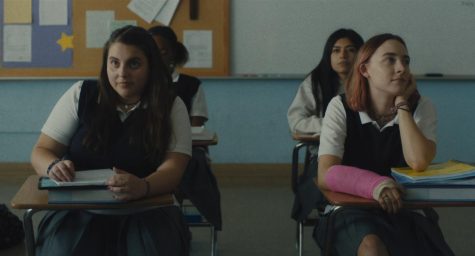Greta Gerwig and the Making of a Woman
April 30, 2021
There have been countless coming-of-age movies made, but none have captured the hearts of teenage girls as much as Greta Gerwig’s directorial debut, Lady Bird. The critically acclaimed 2017 movie follows 17-year-old Christine “Lady Bird” McPherson, played by Saoirse Ronan, through her senior year of high school. The audience watches as she fumbles through relationships and her own identity as a young woman. Critics of the film criticize its perceived unoriginality – there is an abundance of coming-of-age movies centering white teenage girls. Heathers, 10 Things I Hate About You, Breakfast Club, and Mean Girls are prime examples of cult classic coming-of-age films. Part of what makes Lady Bird so different is Gerwig’s careful attention to the seemingly mundane. Time Magazine describes the movie as “one we think we’ve seen, but never in quite this way”, and Vox comments that “It’s a quiet celebration of details that are often effaced or ignored, and that makes it feel aesthetically fresh”. The aforementioned cult classics are epic dramas, with the plot as the major catalyst. Lady Bird, in contrast, employs the characters themselves as the driving forces for change within the movie. People enter and leave Lady Bird’s life, and time allows her to silently reflect on those relationships.
Greta Gerwig’s lived experiences as a woman allowed her to craft a womanhood for Lady Bird. Most popular coming-of-age movies about young women are paradoxically both written and directed by men. These men don’t understand girlhood, and frankly, don’t bother to learn. What these movies lack in realism is made up for in excitement, but the teenage girls that the movies are aimed towards end up with flat caricatures that look like them instead of fully developed characters that act and feel like them. The same Time article describes Lady Bird as “one of the few Best Picture nominees to take a teenage girl’s interior life seriously”. While writing the script for the movie, Greta Gerwig translated pieces of her own life onto Lady Bird’s fictionalized life. Gerwig, like Lady Bird, grew up in Sacramento, and the character draws special attention to “all those bends I’ve known my whole life” in the final montage in the movie. Gerwig admits in an interview with Screen Daily that although she and Saoirse Ronan are “both more people-pleasers and rule-followers” as opposed to Lady Bird’s free spirit, Lady Bird was “the person [they] wanted to be”. After watching the movie, many wouldn’t describe Lady Bird as a role model, but her self-assurance and confidence is inspiring to teenage girls. So many movies aimed at teenage girls demonize confidence and drive.

The making of Lady Bird was a continuous effort. Although Gerwig wrote the script by herself, Saoirse Ronan told Screen4, “I was actually amazed at how much freedom [Greta Gerwig] gave me to find her, to find Lady Bird”. By allowing Saoirse Ronan space to mold Lady Bird out of her own experiences, Gerwig was able to combine both perspectives to more wholly portray a teenage girl. Another aspect of Greta Gerwig’s continuous creative process that made Lady Bird so great was her past experiences as an actor and writer, particularly her work in the 2012 movie, Frances Ha.
Directed by her partner Noah Baumbach, Gerwig played the title role of Frances Halladay as well as contributed to the screenplay of the film. Soon after the release of Lady Bird, fans were quick to point out the similarities between the two characters. Both young women are Sacramento natives going to school in New York, dealing with financial struggles that restrain them. More important than their external similarities, their personalities also mirror one another. Like Lady Bird, Frances is free-spirited, self-assured, and at times, childish. The age difference between the characters materializes in their actions. 17-year-old Lady Bird is quick to act, often blurting things out at the expense of her core relationships – between her mother and her best friend. 27-year-old Frances Ha is more deliberate in her actions, often holding back doing what she loves because of sacrifices she has to make to chase her dreams. As The Michigan Daily puts it, “If Lady Bird explores the idealism and the beckoning promise of growing up, then Frances Ha admits the necessary, all-consuming strife that comes with that pursuit.” In other words, Lady Bird is the idealism of wanting to be a self-assured young woman, while Frances Ha is the reality of being one. The clear parallels between the two character’s journeys illustrate that Greta’s experience with her role of Frances Ha prepared her to adequately portray a young woman.
Gerwig’s efforts led to both critical and commercial success. Grossing worldwide at almost $79 million with a 99% score on Rotten Tomatoes, Lady Bird gave millions of girls a chance to truly see themselves onscreen, with all the messiness that comes with being a contemporary teenage girl. Lady Bird’s triumph proves two important points – that girl-centered media is important enough to produce, and that young women will stand behind a good representation of themselves.
